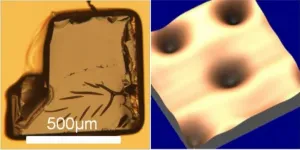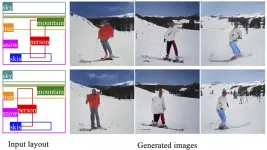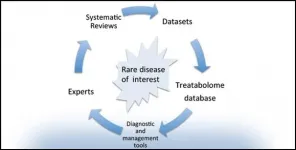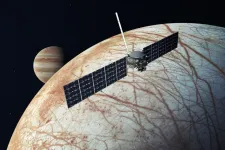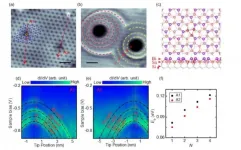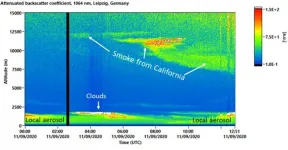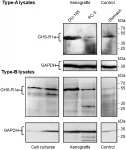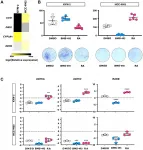(Press-News.org) Physicists at the University of Bath in the UK, in collaboration with researchers from the USA, have uncovered a new mechanism for enabling magnetism and superconductivity to co-exist in the same material. Until now, scientists could only guess how this unusual coexistence might be possible. The discovery could lead to applications in green energy technologies and in the development of superconducting devices, such as next-generation computer hardware.
As a rule, superconductivity (the ability of a material to pass an electrical current with perfect efficiency) and magnetism (seen at work in fridge magnets) make poor bedfellows because the alignment of the tiny electronic magnetic particles in ferromagnets generally leads to the destruction of the electron pairs responsible for superconductivity. Despite this, the Bath researchers have found that the iron-based superconductor RbEuFe4As4, which is superconducting below -236°C, exhibits both superconductivity and magnetism below -258°C.
Physics postgraduate research student David Collomb, who led the research, explained: "There's a state in some materials where, if you get them really cold - significantly colder than the Antarctic - they become superconducting. But for this superconductivity to be taken to next-level applications, the material needs to show co-existence with magnetic properties. This would allow us to develop devices operating on a magnetic principle, such as magnetic memory and computation using magnetic materials, to also enjoy the benefits of superconductivity.
"The problem is that superconductivity is usually lost when magnetism is turned on. For many decades, scientists have tried to explore a host of materials that have both properties in a single material, and material scientists have recently had some success fabricating a handful of such materials. However, so long as we don't understand why the coexistence is possible, the hunt for these materials can't be done with as fine a comb.
"This new research gives us a material that has a wide temperature range where these phenomena co-exist, and this will allow us to study the interaction between magnetism and superconductivity more closely and in great detail. Hopefully, this will result in us being able to identify the mechanism through which this co-existence can occur."
In a study published in Physical Review Letters, the team investigated the unusual behaviour of RbEuFe4As4 by creating magnetic field maps of a superconducting material as the temperature was dropped. To their surprise, they found the vortices (the points in the superconducting material where the magnetic field penetrates) showed a pronounced broadening near the temperature of -258°C, indicating a strong suppression of superconductivity as the magnetism turned on.
These observations agree with a theoretical model recently proposed by Dr Alexei Koshelev at Argonne National Laboratory in the USA. This theory describes the suppression of superconductivity by magnetic fluctuations due to the Europium (Eu) atoms in the crystals. Here, the magnetic direction of each Eu atom begins to fluctuate and align with the others, as the material drops below a certain temperature. This causes the material to become magnetic. The Bath researchers conclude that while superconductivity is considerably weakened by the magnetic effect, it is not fully destroyed.
"This suggests that in our material, the magnetism and superconductivity are held apart from each other in their own sub-lattices, which only minimally interact," said Mr Collomb.
"This work significantly advances our understanding of these rare coexisting phenomena and could lead to possible applications in the superconducting devices of the future. It will spawn a deeper hunt into materials that display both superconductivity and magnetism. We hope it will also encourage researchers in more applied fields to take some of these materials and make the next-generation computing devices out of them.
"Hopefully, the scientific community will gradually enter an era where we move from blue-sky research to making devices from these materials. In a decade or so, we could be seeing prototype devices using this technology that do a real job."
The American collaborators for this project were the Argonne National Laboratory, Hofstra University and Northwestern University.
INFORMATION:
A catastrophic drop in atmospheric ozone levels around the tropics is likely to have contributed to a bottleneck in the human population around 60 to 100,000 years ago, an international research team has suggested. The ozone loss, triggered by the eruption of the Toba supervolcano located in present-day Indonesia, might solve an evolutionary puzzle that scientists have been debating for decades.
"Toba has long been posited as a cause of the bottleneck, but initial investigations into the climate variables of temperature and precipitation provided no concrete ...
In interstellar dust clouds, turbulence must first dissipate before a star can form through gravity. A German-French research team has now discovered that the kinetic energy of the turbulence comes to rest in a space that is very small on cosmic scales, ranging from one to several light-years in extent. The group also arrived at new results in the mathematical method: Previously, the turbulent structure of the interstellar medium was described as self-similar - or fractal. The researchers found that it is not enough to describe the structure mathematically as a single fractal, a self-similar structure as known from the Mandelbrot set. Instead, they added several different fractals, so-called multifractals. The new methods can thus be used to resolve ...
Researchers from North Carolina State University have developed a new state-of-the-art method for controlling how artificial intelligence (AI) systems create images. The work has applications for fields from autonomous robotics to AI training.
At issue is a type of AI task called conditional image generation, in which AI systems create images that meet a specific set of conditions. For example, a system could be trained to create original images of cats or dogs, depending on which animal the user requested. More recent techniques have built on this to incorporate conditions regarding an image layout. This allows users to specify which types of objects they want to appear in particular places on the screen. ...
Amsterdam, June 1, 2021 - The Treatabolome project is a research initiative to develop a freely available, interoperable online platform dedicated to disseminating rare disease and gene-specific treatment information to healthcare professionals regardless of their level of specialized expertise. Developed under the Solve-RD European Research Project, it is intended to reduce treatment delays for patients with rare diseases by directly linking diagnosis and treatment information. This initiative is highly relevant to neuromuscular disorders as they are rare diseases by definition. In this special issue of the Journal of Neuromuscular Diseases, experts contribute Treatabolome-feeding systematic literature reviews on rare neurological ...
Neutrons - Space ice, un-Earthly cold
Researchers from NASA's Jet Propulsion Laboratory and Oak Ridge National Laboratory successfully created amorphous ice, similar to ice in interstellar space and on icy worlds in our solar system. They documented that its disordered atomic behavior is unlike any ice on Earth.
The findings could help interpret data from future NASA missions such as Europa Clipper, which will assess the habitability of Jupiter's moon, Europa.
Using the Spallation Neutron Source's SNAP instrument, the scientists replicated the cold vacuum of space and added a few molecules ...
Single atomic defect is the smallest structural unit of solid material. The construction of devices based on single defect can reach the limit of miniaturization of semiconductor devices. In the past decades, the creation and manipulation of single defects in semiconductors opened a new research field, and could be used to physically realize "qubits" of solid-state quantum computation through spin or electron charge. Most interest have focused on the studies of spin quantum computing. However, the spin manipulation need an optical and magnetic field. On the contrary, multiple ...
Leipzig. The smoke from the extreme forest fires on the US West Coast in September 2020 travelled over many thousands of kilometres to Central Europe, where it continued to affect the atmosphere for days afterwards. A comparison of ground and satellite measurements now shows: The forest fire aerosol disturbed the free troposphere over Leipzig in Germany as never before. An evaluation by an international research team led by the Leibniz Institute for Tropospheric Research (TROPOS) revealed an extraordinary optical thickness on 11 September 2020, which attenuated ...
Oncotarget published "Development of a ghrelin receptor inverse agonist for positron emission tomograph" which reported that imaging of Ghrelin receptors in vivo provides unique potential to gain deeper understanding on Ghrelin and its receptors in health and disease, in particular, in cancer.
Ghrelin, an octanoylated 28-mer peptide hormone, activates the constitutively active growth hormone secretagogue receptor type 1a with nanomolar activity.
The authors developed novel compounds, derived from the potent inverse agonist K- -FwLL-NH2 but structurally varied by lysine conjugation ...
Oncotarget published "Global DNA hypermethylation pattern and unique gene expression signature in liver cancer from patients with Indigenous American ancestry" which reported that contrasting with this pattern, the age structure of HCC in Andean people displays a bimodal distribution with half of the patients developing HCC in adolescence and early adulthood.
To deepen the understanding of the molecular determinants of the disease in this population, the authors conducted an integrative analysis of gene expression and DNA methylation in HCC developed by 74 Peruvian patients, including 39 adolescents and young adults.
While genome-wide hypomethylation ...
New research from the Prevention Research Center of the Pacific Institute for Research and Evaluation, The Ohio State University, and San Jose State University finds that during COVID-19 stay-at-home orders, parental stress was higher during the workday compared to after the workday and lower during weekends than during weekdays.
Previous research compares parental stress before and during the pandemic, but none has measured it during stay-at-home orders. In this study, scientists assessed how time-varying and day-varying factors are related to parents' level of stress. In specific, stress was examined 3 times a day for 14 days for survey participants in Ohio from April to May 2020.
Specific findings include:
Parents ...
